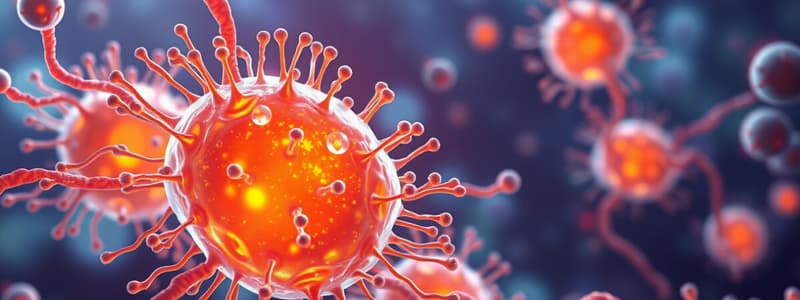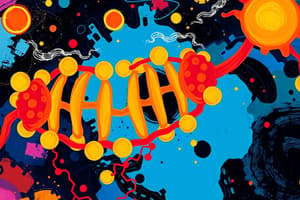Podcast
Questions and Answers
What is the primary function of ribosomes?
What is the primary function of ribosomes?
- Movement of materials over the cell membrane
- Control of metabolism
- Protein synthesis (correct)
- Break down organic compounds
What are cilia primarily used for?
What are cilia primarily used for?
- Movement of materials over the cell membrane (correct)
- Increase surface area
- Production of ATP
- Containment of DNA
What is the essential function of the centrosome with centriole?
What is the essential function of the centrosome with centriole?
- Facilitate absorption
- Movement of chromosomes during cell division (correct)
- Storage of genetic information
- Protein synthesis
What is the primary function of microvilli?
What is the primary function of microvilli?
What is the structure and function of cytoskeleton?
What is the structure and function of cytoskeleton?
What function does the peroxisome serve?
What function does the peroxisome serve?
What is the main function of mitochondria?
What is the main function of mitochondria?
What does the nucleus control?
What does the nucleus control?
What are the main functions of the Endoplasmic Reticulum?
What are the main functions of the Endoplasmic Reticulum?
What is the role of the Golgi Apparatus?
What is the role of the Golgi Apparatus?
What do lysosomes do?
What do lysosomes do?
Flashcards are hidden until you start studying
Study Notes
Nonmembranous Organelles
- Ribosomes: Composed of RNA and proteins; their primary function is protein synthesis by bringing together amino acids.
- Cilia: Membrane extensions containing microtubules arranged in a 9 by 2 pattern; facilitate movement of materials over cell surfaces.
- Centrosome with Centrioles: Structure made of centrioles composed of 9 by 3 microtubules; critical for chromosome movement during mitosis.
- Microvilli: Membrane extensions with microfilaments; enhance cell surface area for increased absorption of extracellular materials.
- Cytoskeleton: Network of proteins organized into fine filaments or slender tubes; provides strength, support, and aids in cellular movement.
Membranous Organelles
- Peroxisome: Vesicles containing degradative enzymes; involved in the catabolism of fats and organic compounds and the neutralization of toxic substances produced during metabolism.
- Mitochondria: Double-membraned organelle with inner membrane folds called cristae; responsible for producing 95% of the ATP needed by the cell.
- Nucleus: Surrounded by a double membrane (nuclear envelope) with nuclear pores; contains nucleoplasm, nucleotides, enzymes, and chromatin, controlling metabolism and storing genetic information. It also plays a role in RNA synthesis and the assembly of ribosomal subunits.
- Endoplasmic Reticulum (Smooth/Rough): Network of membranous channels; rough ER is studded with ribosomes for protein synthesis, while smooth ER is involved in lipid and carbohydrate synthesis, and calcium ion storage. Functions include synthesis of secretory products and intracellular transport.
- Golgi Apparatus: Stacks of flattened membranes (cisternae) that serve as a storage and packaging center for secretory products and lysosomal enzymes; plays an essential role in modifying and exporting proteins (exocytosis).
- Lysosome: Vesicles filled with digestive enzymes; responsible for the intracellular removal of damaged organelles and pathogens.
Studying That Suits You
Use AI to generate personalized quizzes and flashcards to suit your learning preferences.




